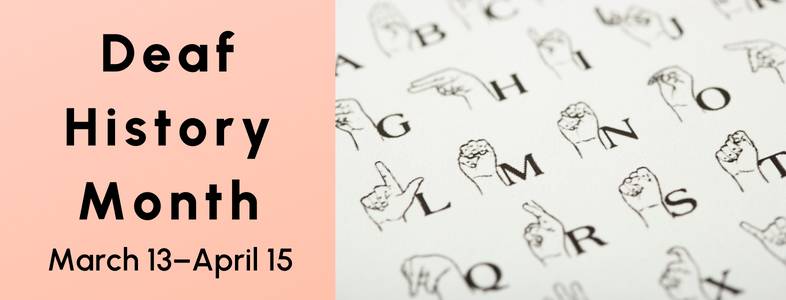
Deaf History Month
Deaf History Month runs from March 13 through April 16 annually. It seeks to highlight successes of those in the deaf and hard of hearing communities, as well as bring awareness to the barriers they face daily.
Whether people call themselves Deaf, deaf, or hard of hearing, or another term, varies from community to community and person to person. Below, we have chiefly used “deaf” if a person’s preferred term is not known.
(A Few) Notable Deaf and Hard of Hearing People
Click the names to find books in the York County Libraries catalog. Click “info” to jump to informative websites.
Read more biographies of deaf and hard of hearing people here
Read more about Sign Language and Deaf Education here
Why these dates?
On March 13, 1988 Gallaudet University hired its first deaf president—a landmark date for the school, which its student body fought for. And on April 15, 1817, the first American public school for the deaf opened in Hartford, Connecticut. It was founded by a number of well-to-do parents of deaf and hard of hearing children. They wanted their children to receive a good education despite their disabilities.
Notable people involved in the founding of the school were Thomas Hopkins Gallaudet; Dr. Mason Fitch Cogswell; and Laurent Clerc, among others. The school still operates today and has expanded to a number of states. It is simply known as the American School for the Deaf. (Prior to its founding, well-to-do parents of deaf children could pay to send their children to a deaf school in Scotland or in France, but other options were limited.) Today, this institution serves as a model for schools around the country.
What’s Gallaudet?
Gallaudet University, in Washington, D.C., is the world’s only liberal arts college for deaf people. Gallaudet has its origins in 1864, when it started as a grammar school for deaf and blind children. In the years since it has grown and changed to meet its students’ needs. A small number of hearing students are now admitted on a few fairly strict conditions. They must show proficiency in American Sign Language (ASL). Additionally, they must plan to pursue education and a career in furthering the education of people who are deaf or hard of hearing (from Hearing Students | Undergraduate Admissions).
Gallaudet University featured in Netflix’s “Deaf U” in 2020, when the streaming platform did a reality TV show-style documentary featuring the student and deaf experience at Gallaudet.
Deaf and Hard of Hearing Facts
One to three out of every 1000 American children has some degree of hearing impairment. Impairment may be temporary, come and go, or be permanent. Depending on a child’s age, it can have different effects on their development.
Worldwide, it is estimated that 5% of people live with a disabling hearing loss. Causes may include one’s genetic background; one’s age (older people tend to lose some hearing ability); injuries, including prolonged exposure to loud noise; illnesses such as meningitis, measles, mumps, rubella, or scarlet fever; or an untreated high fever, encephalitis, or bacterial infection, especially when these occur in children.
Further Reading
Ready to learn more? Find books, documentaries, and more about the deaf experience for all ages here: Search Results – York County Libraries (chilipac.com)
Learn the basics of ASL for free with your YCL card with Rocket Languages
Or check out “See What I’m Saying: the Deaf Entertainers’ Documentary” (PG-13) from York County Libraries to explore just one aspect of the Deaf community.
Sources of Interest
Check out some of the additional interesting sources consulted for this blog:
Deaf authors and writers to read and follow | Hearing Like Me
Deaf History Month – March 13th to April 15th | Alachua County Library District (aclib.us)
How did Beethoven Keep Composing After Hearing Loss?
PAHO/WHO | Many countries lack capacity to prevent and treat hearing loss
